By Robert Bruce
Metal Storm is a radically different concept for weapons and ammunition, the brainchild of a self-educated Australian inventor with brilliant intuition for practical applications in engineering, physics and electronics. Following its genesis in the early 1990s, this novel electronic ballistics technology has suffered from what might charitably be termed unrealistic expectations.
Early claims of a rate of fire capability at 1 million rounds per minute inspired some fanciful applications ranging from covert wrist guns to missile defense. Metal Storm has been a darling of the media, frequently seen on the Discovery Channel and others in highly sensationalized depictions of supergun abilities. In one particularly memorable TV episode of CSI Miami, Metal Storm-like guns were seen literally vaporizing anyone who was on the muzzle end of this terrifying weapon.
Million Rounds a Minute
James Michael O’Dwyer was 47 years old in 1991 when he sold his successful food wholesale business to devote his full energies to various inventions. Two years later, he bet the remainder of his life savings and all the money he could borrow on development of a unique weapon system that, he strongly believed, would have revolutionary applications in military and law enforcement.
Years of work in O’Dwyer’s backyard garage/laboratory ultimately yielded what would become the internationally patented Metal Storm System. A breakthrough came in 1996 when a formal study by US defense giant Lockheed Martin provided essential third-party validation for the radical concept.
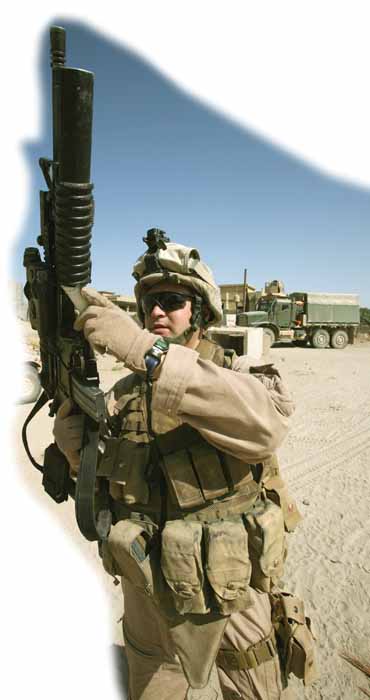
Building on success of his single barrel prototype, constructed with the help of a local Australian engineer named Graham Bugden, O’Dwyer’s next breakthrough came in captivating media attention with a dramatic demonstration video. News organizations worldwide picked up the demo clip showing an incomprehensibly fast burst of 9mm rounds from a box of 36 bullet-stacked barrels that O’Dwyer had whimsically named “Bertha.” A lightning strike blast of 180 rounds stormed out in about one hundredth of a second. Yes, that’s a rate of fire better than one million rounds a minute.
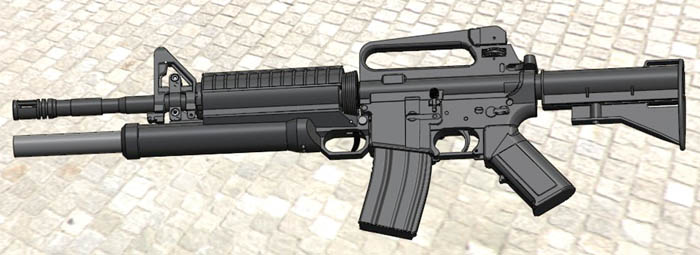
Bertha showed the way to a variety of devices utilizing O’Dwyer’s clever stacked munitions principle. Prominent among these are a “smart” handgun, remotely fired munitions to replace traditional minefields, close-in protection for vehicles against ambushers and incoming rockets, plus gun pods for robotic vehicles.

But, thus far, none of these has achieved commercial success.
Game-Changing Technology
Finally, after many years of work, fueled by multimillions of dollars in developmental funding from private investors, industry partners and various military entities, the radically unconventional Metal Storm system seems on track for fielding in key roles in the Global War on Terror.
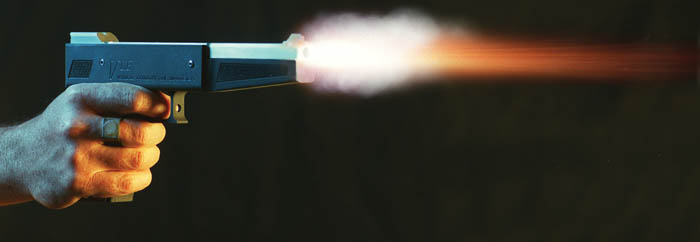
We recently talked to Metal Storm to separate the truth from the fiction and get an update on how the company has progressed from the patent office to the marketplace.
Peter Faulkner, General Manager of Metal Storm Incorporated, the U.S. licensee of Metal Storm Limited in Australia, told us, “The company has become intensely focused on product development over the past three years and the work is beginning to pay off. We are close to offering the military and law enforcement communities real products rather than ideas.”
The real products Faulkner is referring to are the MAUL, 3GL and FireStorm. Not nearly the million rounds per minute, battlefield clearing supergun once imagined by the Metal Storm inventor, but certainly more relevant to current tactical applications.
MAUL Underbarrel Shotgun
Breaching shotguns of various types are in widespread use by American forces; all relatively heavy and mechanically actuated in form and function essentially unchanged for more than a century.
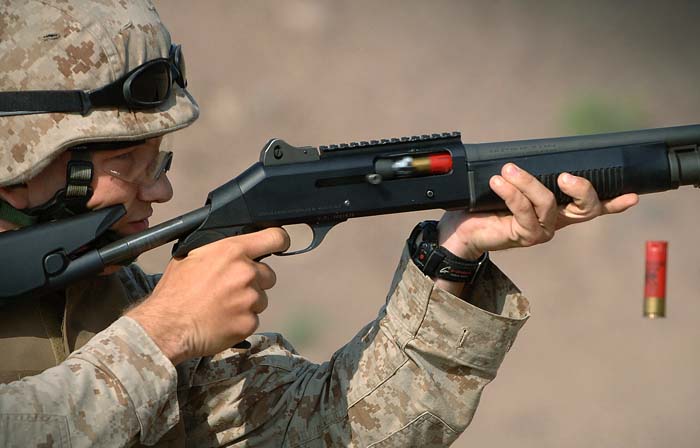
The Office of Naval Research, acting on behalf of the US Marine Corps, turned to MS for a better solution. Of particular interest was the need to more efficiently launch the devilishly effective FRAG-12 fin-stabilized high explosive 12 gauge projectiles.
This was a Marine Corps Warfighting Laboratory project to see if these specialized breaching rounds could be stacked. MS delivered a bench test gun that proved successful as seen in live fire video linked on the MS website. This has led to an ONR contract to actually build a weapon for the M4 carbine, the weapon of choice for MOUT scenarios, along with lethal and non lethal rounds.
It’s now known as MAUL, a particularly appropriate acronym derived from its formal name of Multishot Accessory Underbarrel Launcher. Backed by funding of nearly a million dollars from ONR, this slim, light, electrically-fired semiauto clamp-on quickly loads with slip-in tubes pre-packed with up to five rounds of various types. MAUL is fast tracked for delivery to the Navy by June 2009 for more detailed operational evaluations.
Caliber: 18mm (12 gauge)
Ammunition: Lethal and less-lethal
Capacity: Up to 5 rounds in preloaded sleeves
Operation: Manually reloaded, electrically fired, semiautomatic
Weight Empty: 2 pounds
3GL Three Shot Grenade Launcher
The 40mm grenade launchers currently in US and allied military service that are suitable for mounting to a primary weapon such as the M4/M16 family are single shot devices. Critical seconds are lost in reloading during intense firefights.
MS offers an alternative in the light and fast-firing 3GL, a semiautomatic grenade launcher with a trio of beefy 40mm rounds stacked in a single barrel. While externally similar to recent modular grenade launchers with a pistol grip and rail mount points, the 3GL can be manually loaded by the soldier with three rounds in any combination of ammunition types, potentially from irritant cloud to high explosive.
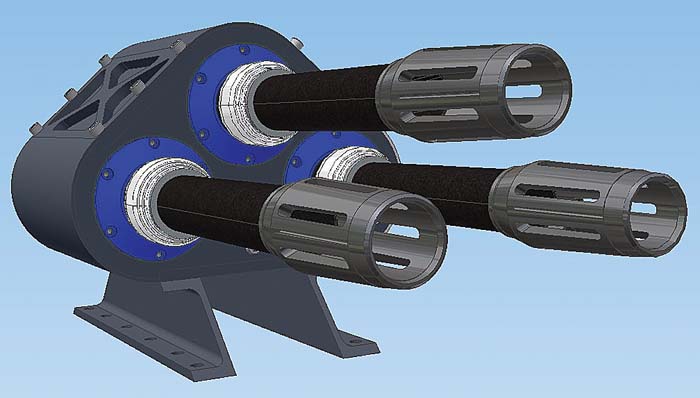
Battery-powered electronic ignition cuts weight and complexity, allowing ultra-fast firing and improved reliability. The grenadier can immediately engage up to three targets, “walk” his rounds to a precise impact point, or put multiple rounds into a single target for maximum effect.
Caliber: 40mm
Ammunition: All common less lethal to lethal payloads
Capacity: 3 rounds
Operation: Manually loaded, electrically fired, semiautomatic
Weight Empty: 5.1 pounds
Configuration: Stand alone or attached to host weapon
The 3GL weapon and a new family of 40mm grenades that can be individually loaded by the grenadier are developing rapidly in close partnership with Singapore Technologies Kinetics (STK), known as one of the largest defense firms in Asia.
Dr. Lee Finniear, Metal Storm Limited’s CEO, confidently anticipates system safety certification so that sales demonstrations can begin soon. “We can confirm that early in the New Year (2009) we expect to qualify the 3GL and ammunition for safe man-firing….”
Multi-Barrel Versatility
Uncle Sam has fielded a wide range of remote controlled weapon mounts suitable for use on vehicles big and small for land, sea and air operations. Their common characteristic is undesirably heavy weight due to the requirement for supporting large and energetically recoiling traditional mechanical guns like the massive .50 cal. M2HB and 40mm MK19.
Metal Storm offers a compelling alternative in Redback, a 4 barrel cluster with advanced fire control and automatic target tracking as an ultra-smart remotely operated weapons system (ROWS). Produced in cooperation with STK and Electro Optical Systems (EOS), it consists of a lightweight gimbal, mount and weapon, weighing approximately 150 pounds. It includes a combat proven fire control system that has thermal and imaging sensors as well as a laser rangefinder with a 5,000 meter range.
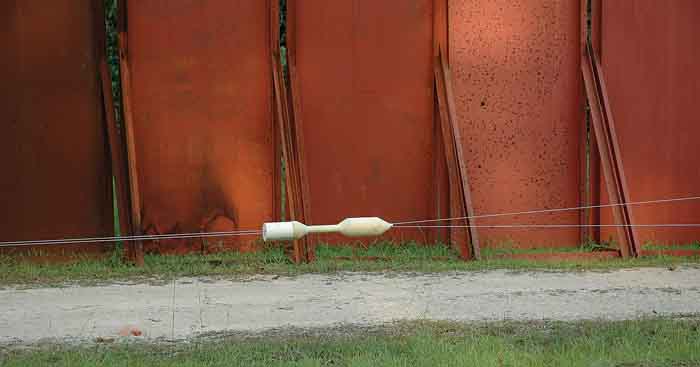
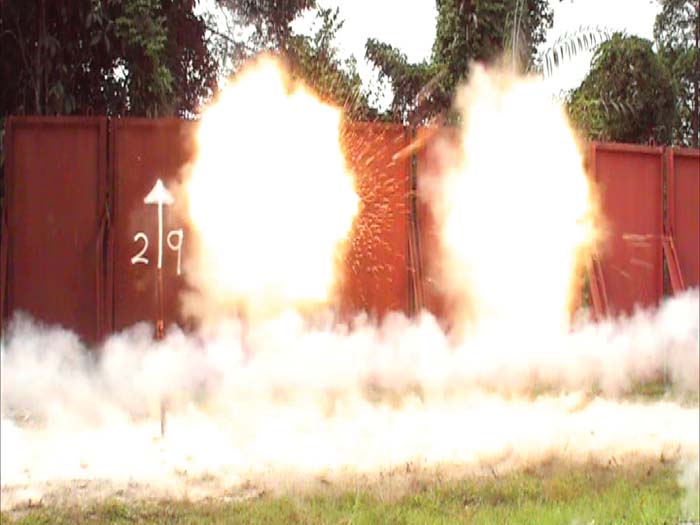
Considerable weight is saved in mounts and the overall system because the MS concept eliminates the bulky housings and complicated mechanical apparatus needed for feeding, extraction and ejection. Additionally, a simple and effective coiled spring around each barrel and built in shock piston systems efficiently counters recoil.
Redback offers a dual role capability with significantly improved lethality and target effect, instantly attacking multiple targets with different munitions and providing a lightweight offensive and defensive capability for all vehicles or fixed assets.
And most dramatically, Redback has shown the capability to intercept rocket propelled grenades using STK’s COTS (commercial off-the-shelf) 40mm airburst munitions. It automatically tracks and registers targets, slewing at speeds up to 700 deg/sec and can acquire and fire at 3 targets in approximately 1.2 seconds, selecting the appropriate munition for each target.
A recently developed universal “tail” housing for its propellant load and primer makes nearly all existing low velocity 40mm projectiles suitable for use in Redback including high explosive, enhanced blast, air burst, and less lethal munitions. This is an important logistical consideration for economy of manufacture and ammunition commonality.
Firepower can be precisely controlled to deliver one or more munition types to target simultaneously, with the operator able to choose both fire rate and ammo to provide an intense and accurate salvo of munitions.
David Pashen, Chief Engineer and Development Manager for Metal Storm’s Australian headquarters, tells us that the work done to date on Redback has been very successful.
“We’ve undertaken tests last year to prove the effect of our rounds on an RPG warhead,” Pashen said, “showing that our system was able to place and detonate two rounds alongside a simulated incoming RPG warhead in full flight.
“The next steps for Redback,” Pashen said, “will be responding to specific customer demands for the capability and the integration of sensors leading into the full automation of the system.”
FireStorm
The four barrel weapon cluster on Redback has given rise to FireStorm, a lighter, simpler and less expensive way to discharge various types of 40mm munitions, tailorable to the tactical situation. As with Redback, electronic ignition of the stacked ammo allows variable firing rates from single shots to as high as 1,800 rpm per tube in recent testing.
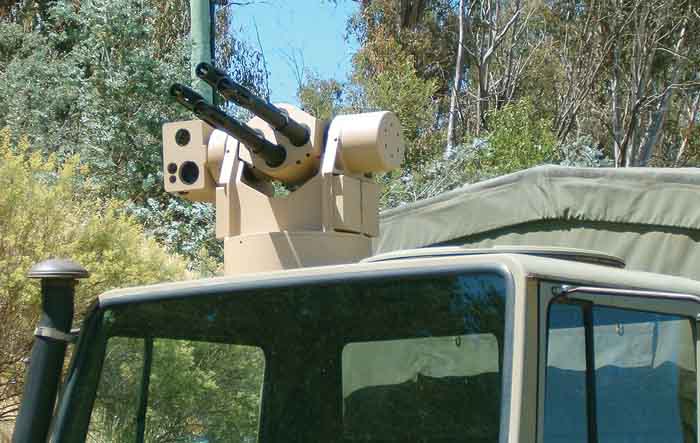
FireStorm is said to have performed well in a recently-completed technology demonstration of a Mission Payload Module – Non-Lethal (MPM-NL), loaded with a selection of “less lethal” chemical and frangible ammunition newly developed by engineers at the Metal Storm US operation. Given the challenges of firing stacks of these rounds without wrecking their fragile projectile cones, this is a remarkable accomplishment unto itself.
The MPM-NL experiment in crowd control was funded by US Marine Corps Systems Command, seeking a better way to handle large scale threats without resorting to deadly force. Metal Storm officials expect to learn sometime in 2009 if contracts are to be awarded.
Battle ‘Bots
The relatively light and definitely fast-shooting FireStorm offers advantages that give it particular prominence in the fast-growing need for arming military and law enforcement robots. Metal Storm weapon modules have been successfully fired aboard Foster-Miller’s TALON and, most recently, iRobot’s Warrior.
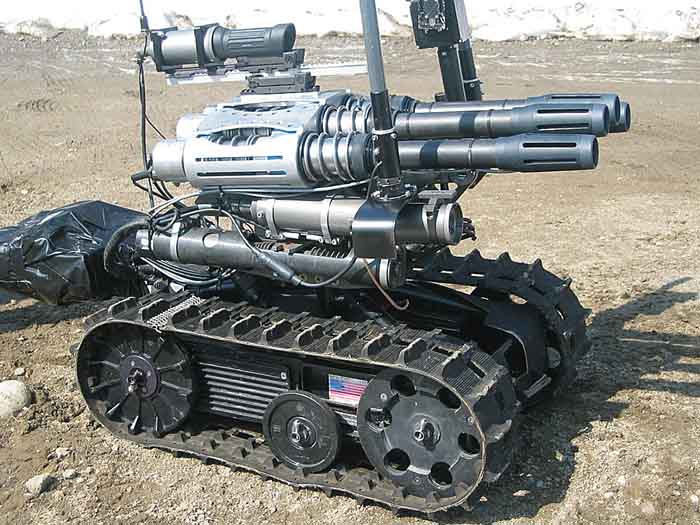
The US Navy’s ultra high tech SPAWAR (Space and Navy Warfare Systems Command) has recently evaluated a robot-riding FireStorm system for its “Anti-Personnel Unattended Weapons Pod” on its own unmanned ground vehicle (UGV).
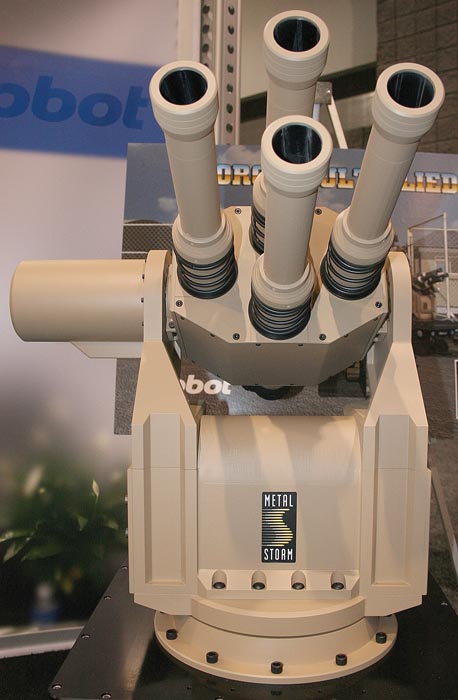
Arthur Schatz, who’s been with Metal Storm from the very beginning and is now VP for Business Development of the US corporation, explained that the purpose of the project was to “show the capability to have robotic systems, networked through a central command post, and patrol a given perimeter for base, area, border or facility protection.”
Schatz, a retired US Navy Commander whose professional contacts had been invaluable in obtaining initial military funding for O’Dwyer’s radical concept, told us that this latest contract culminated in a successful demonstration of the system and – when funding comes available – follow-on work is anticipated.
What’s Next?
Dr. Lee Finniear, CEO of the Australian Metal Storm Ltd, is predicting commercial success in the near future for MAUL, 3GL and FireStorm. He also sees “a number of derivatives…we plan to expand our munitions to provide the suite of lethal and less lethal munition natures that customers expect.”
Compatibility with robotic platforms is also an ongoing key focus. “The electronic lightweight nature of our technology provides substantial advantages for weaponizing small and mid-range robots,” Finniear said.
For the medium term, Finniear revealed that Metal Storm has no immediate plans to enter the arena now entirely dominated by traditional high velocity systems like the MK19 grenade machine gun. “We are finding a niche in close-in to medium range weapons and have also invested heavily in less lethal applications of our weapons.”
All in the Family
Finniear has ambitious goals for the future of the Metal Storm system, particularly in view of the collaboration agreement with STK. “Our development plan will provide the company with a family of low velocity weapons, a suite of supporting munitions, and an additional caliber in the 12 gauge MAUL weapon, he told us. “This platform really adds value to Metal Storm as a company and provides the commercial base to deliver a much wider range of capability applications.”
Postscript
Credible news reports dating from 2006 reveal a pattern of energetic attempts by China to acquire Metal Storm’s technological secrets. It is said that the Peoples Liberation Army has offered a bounty of as much as $100 million Australian dollars (about $68 million USD) for data packages. O’Dwyer himself is reported to have emphatically rebuffed an invitation accompanied by a similar sum to live and work in Beijing. There must be more to all this than just Roman Candles.
Unique Stacked Ammunition
The secret of Metal Storm is an electronically initiated, stacked projectile system that removes the mechanical elements required to fire conventional weapons. Projectiles in the barrels are lined up nose to tail and patented technology provides the ability to fire each round independent of the other. When the propellant of one round in the stack is ignited the other rounds are not affected.
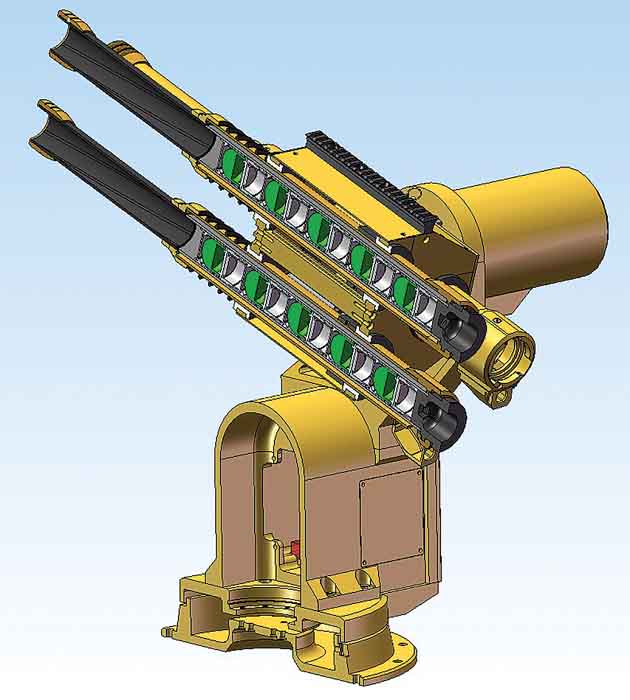
Rather than using a firing pin impacting on a primer, Metal Storm weapons are electronically fired utilizing a computerized fire control system which precisely controls the ignition signal to each round in the barrel. As there is no need to mechanically reload the barrel after each round is fired, Metal Storm has complete control over the timing and rate of fire. The weapon can be used to deliver a single round or dozens of rounds instantaneously at the target.
When combined with airburst munitions, Metal Storm weapons can use precisely timed firing to create a pattern of fragmentation and blast to meet specific needs, such as to intercept an incoming RPG or missile.
Due to the light weight of Metal Storm barrels, most non-infantry configurations use multiple barrels, usually between 4 and 64. This provides increased firepower and the ability to mix munitions – to have a weapon configured to respond to different threats in different ways – such as having less than lethal or marker rounds instantly available as an alternative to the use of lethal force.

Inventor Mike O’Dwyer’s first Metal Storm rounds were essentially caseless, not unlike multiple loadings of a musket with powder topped by a patch and a cone shaped Minie Ball. These were specially contrived to take advantage of recoil forces causing “wedging and sealing” of the rounds behind. So, unlike the Roman Candle, firing the foremost one in the barrel would not normally ignite the next.
While this performed quite well, only proprietary Metal Storm loadings could be used. Practical considerations have since led to the development of a special “tail” that facilitates individually loaded cartridges for Metal Storm’s 40mm family. Now, many COTS (commercial off-the-shelf) projectiles for 40mm low-velocity weapons can be readily adapted for firing. This is particularly important to Metal Storm partner Singapore Technologies Kinetics with its extensive catalog of munitions ranging from crowd-control sponge grenades to cave-clearing thermobarics.
The new tail has undergone a great deal of development and iterative testing; producing a unit that is easy to load individually and also provides the ability to hold the rounds together during firing. Although preliminary tests have been carried out on the HEDP and practice round, the tail can be retro fitted to other munitions with little or no effort. This enables them to be fired from a 3GL launcher, either in single or stacked configurations dependant on their length.
Mindful of an oft-raised concern, we asked David Pashen, Chief Engineer and Development Manager in the company’s Australian home office, about vulnerability to accidental detonation from outside electrical sources. An emailed response from this former Major in the British Army’s Royal Mechanical and Electrical Engineers is worthy of presenting here in full:
“All Metal Storm weapon systems are designed to meet military standards for EMI (electro-magnetic interference) when used on Ground Mobile, Aircraft and Shipboard applications. As the energy levels required to initiate the charge are high, the chances of accidental detonation are extremely small. In fact to date in all tests of high levels of electronic interference it has not been possible to ignite a charge on our system. The most challenging of the use environments would be on the deck of a Navy ship or fitted to a helicopter. A high powered radar dish whilst it is operating can be problematic; however the ability to shield our technology electronically from interference in such extreme circumstances precludes any potential hazard.”
Find Out More
Metal Storm Limited has a particularly information-rich website with excellent photos and videos, plus detailed descriptions of its many products, technologies and capabilities: www.metalstorm.com
Metal Storm Limited is a multi-national defense technology company engaged in the development of electronically initiated ballistics systems using its unique “stacked round” technology. The company is headquartered in Brisbane, Australia and separately incorporated in the US, with an office in Arlington, Virginia.
Metal Storm is working with government agencies and departments, as well as industry, to develop a variety of systems utilizing its proprietary technology; an electronically initiated, stacked projectile system which removes the mechanical steps required to fire a conventional weapon. Effectively, the only parts that move are the projectiles contained within the barrels. Multiple projectiles are stacked in a barrel, each separated by a propellant load. The technology allows each projectile to be fired sequentially from the barrel.
Metal Storm’s fully loaded barrel tubes are essentially serviceable weapons, without the traditional ammunition feed or ejection system, breech opening or any other moving parts. Metal Storm barrels can be effectively grouped in multiple configurations to meet a diversity of applications.
Metal Storm technology enables a new generation of “network centric” weapons that connect with today’s battlefield. Importantly, Metal Storm enabled systems are all capable of local or remote operation through a computerized fire control system.
The elements which differentiate Metal Storm technology provide for a number of key capability advantages not available from conventional weapon technology:
- Increased lethality from conventional warheads
- Cumulative effect of firepower
- Simultaneous delivery of different munitions
- Instant selectable choice of munitions
- Variable rates of fire
- Intense bursts of repeatable firepower
- Scaled response
- Remote operation
Mr. Metal Storm
“For the first twenty minutes I thought Mike was certifiably mad.” General Wayne Downing, Former Commander of US Special Operations Command
Downing recalled this troubling observation from his initial contact with the intensely focused O’Dwyer, who was making yet another in a seemingly endless string of impassioned but ultimately futile sales presentations in Australia and America.
But that quickly changed. “After thirty minutes I realized that Mike had stumbled on probably the most revolutionary thing that could be done with firearms in about the last five hundred years,” Downing said.
The retired General, a legend in the Special Operations community, was so impressed with O’Dwyer’s radical invention that he accepted the top position at Metal Storm Limited, coming aboard in October 1999. Over the next seven years, Downing’s reputation and contacts are said to have contributed substantially to multimillion dollar government contracts for further development of the technology in various novel applications.
Midnight Brain Storms
Going Ballistic, an Australian Broadcasting Corporation television documentary from 2000, has a collection of fascinating interviews with O’Dwyer himself and key persons in his life and work.
Through it we learn that the inventor admits to being “not a particularly good student” during his high school years in a small town in Queensland, Australia. Interested primarily in the odd combination of physics at school and working on cars in his stepfather’s auto repair business, after graduation he chose to enter the workplace rather than continue on to college.
O’Dwyer’s personal and professional traits contributed to a quick rise to management level in retail and then in founding his own highly successful food wholesale company. But his compulsion for invention would not relent and the products of inspiration when he would awaken suddenly in the middle of the night began to fill a bedside sketchbook.
His son Sean recalls pages upon pages of “engines and wings and carpets and electrical points… maybe 50 ideas.” Passion for invention eventually overcame the need for comfort and security in the business world. With the blessing of his wife Rhonda, O’Dwyer sold everything in 1991 and literally took a giant step into development of his amusing concept for running shoes cooled by forced air generated from each impact on the ground.
But breezy footwear would soon give way to a dream of fantastic firepower.
Mrs. O’Dwyer recalls the genesis of Metal Storm in 1993 as yet another of her eccentric spouse’s insomniac insights. “He just woke up and he said ‘I’ve improved the gun. I’ve got to go and put this on paper,’ and he doodled for an hour or so.”
The revolutionary concept at the heart of today’s Metal Storm technology has been described by its inventor as a modification of the common fireworks Roman Candle so that its projectiles may be initiated with computerized precision.
Doodles eventually took form in a single barrel prototype and, after much ammunition experimentation, proved the practicality of sequential electronic firing of stacked caseless projectiles. With the system’s enormous military potential clearly foreseen in his fertile imagination, Mike O’Dwyer sought to convince Australia’s military establishment to bankroll further development.
“To say that I was treated as though I was a friendly kook,” the inventor recalls, “would be a polite description of the response.”
Undaunted, O’Dwyer set off to America, only to experience months of futility being rebuffed by every possible contact in the Pentagon. His luck didn’t change until after the system received a successful technical validation from a major US defense contractor.
This must have been what it took to convince Australia’s Defense Science and Technical Office (DSTO) to take a closer look, soon followed by significant funding and direct collaboration in hardware development. In addition to facilitating a distinctive trio of Metal Storm weapons from pistol to cannon caliber, the partnership gave much-needed official gravitas. Now, the “kook” inventor had the backing of serious scientists and engineers from his homeland’s defense establishment.
Blossom Point Demo
The reader is urged to access the MS website www.metalstorm.com and click the VIDEOS link. Skip the latest postings for now and reach back to July 2000, when several of the mysterious new Metal Storm weapons were live fired for key military and government representatives at the Army Research Laboratory’s Blossom Point Facility in Maryland.
This extraordinary demonstration, a joint presentation by DSTO and Metal Storm, along with new US partner Science Applications International Corporation, was attended by a number of decision makers from DARPA, the American military’s Defense Advanced Research Projects Agency. With deep pockets to bankroll cutting-edge technologies, DARPA’s backing was eagerly sought.
It’s likely that the fellow wearing a straw hat, fleetingly seen in the video, is O’Dwyer himself, cheerfully firing his VLe handgun and touching off a megafast burst from a bench test pepperbox containing six pistol caliber barrels. This produces a devastating effect on a rack of target boards and then an oddly wired tube blows 40mm holes in a junk car.
While clear tactical applications for these lethal curiosities would not gain real acceptance until several years later, it should be evident to those who view this historic video that the “certifiably mad” inventor was definitely on to something big. DARPA’s emissaries apparently agreed and, in November 2000, entered into an unprecedented developmental agreement with DSTO, together committing some $50 million dollars.
This correspondent first met O’Dwyer in May of 2001 at the prestigious NDIA Small Arms Conference, where Metal Storm had a display booth and also presented a formal technical paper to influential US and Allied defense industry personnel. Having elbowed through the crowd gathered to watch the heretofore little known firm’s dramatic video clips, we were approached by a slight and somewhat owlish fellow who introduced himself as Mike.
Turned out this was the modest but intense inventor, who proceeded to give our modest but intense magazine a personally guided tour of his visionary applications for the decidedly radical Metal Storm System. Alas, Mike had no hardware on hand to fondle and no planned participation at the annual event’s customary live fire demonstrations. So we politely listened, accepted colorful brochures and promised to stand by for further news.
Mike made sure we were on Metal Storm’s list for press releases and they began regularly arriving; product pages, as it were, for a growing catalog of delightfully intriguing weaponry.
We soon learned, for example, that techno-spooks at DARPA had awarded more than $10 million to Metal Storm for an “Advanced Sniper Rifle.” No, the end result wasn’t fielded, but that doesn’t mean the program’s resulting data package for launching innovative projectiles at hypervelocity will not find practical application elsewhere and later. It’s Metal Storm’s proprietary intellectual property that they just haven’t gotten around to yet for further development.
O’Dwyer continued to promote Metal Storm technology with missionary zeal, envisioning all manner of applications – not just military. At the heart of its civilian potential was a versatile mortar box with specialized loadings. These could be for precision fireworks displays, “sky typing” advertising messages, bombarding wildfires with suppressant chemicals, spreading pesticides and fertilizer, and mineral exploration seismology.
Nothing Personal, Just Business
While the scope of this article does not include details of the corporation’s complicated financial history, the wild ride for Metal Storm’s shareholders has been reliably reported over many years. New applications and new government experimental contracts were periodically trumpeted in press releases and news features, but no real orders for hardware were forthcoming. Investors, many of whom were regular folks of modest means, were justifiably unhappy.
Veteran insiders in the corporate structure are quick to credit O’Dwyer’s demonstrated genius and tireless promotional contributions. But, we were told in carefully crafted statements, the time came when it was necessary for “the face of Metal Storm” to step aside.
A corporate press release from February 2005 announced Director O’Dwyer’s retirement with the bland assurance that “he will continue to provide consulting advice to the company from time to time in an informal, unpaid basis.”
The inventor/founder signed over “certain existing and future intellectual property rights,” and agreed to “certain non-competition arrangements.” Then, in recognition of nearly two decades in building Metal Storm, O’Dwyer received a severance package of a half million Australian dollars (about $345,000 USD).
A gentleman to the end, James Michael O’Dwyer is quoted in the same release with a rather gracious parting shot. There is much to be learned by those who carefully read it and consider all that has been reported in this feature:
“Over the past twelve months, Metal Storm has been assembling a skilled team of qualified engineers and associated professionals to concentrate on commercialization of the technology. Now that the team is fully operational, I believe it is time to pass the baton to what is a new generation. I am confident that under the leadership of David Smith, the team can complete the next stage of the company’s development,” O’Dwyer said.
| This article first appeared in Small Arms Review V12N11 (August 2009) |











